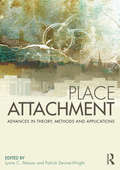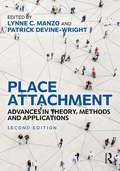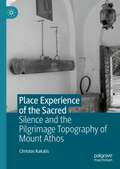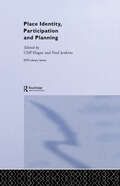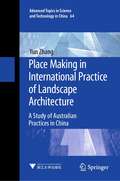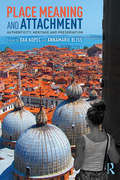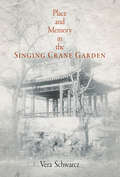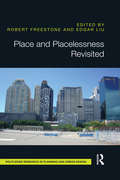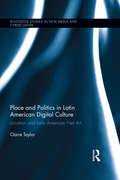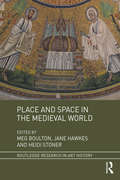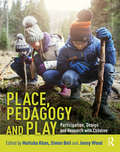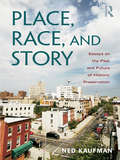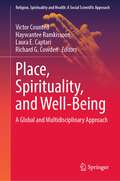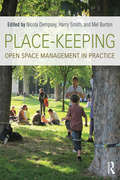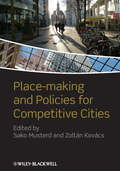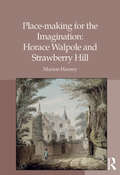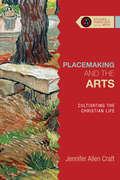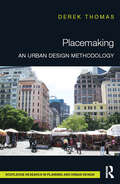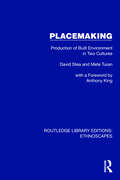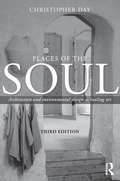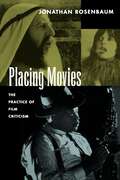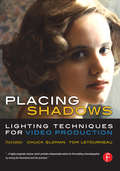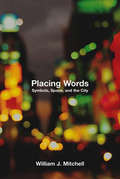- Table View
- List View
Place Attachment: Advances in Theory, Methods and Applications
by Patrick Devine-Wright Lynne C. ManzoRecipient of the 2014 EDRA Achievement Award. Place attachments are emotional bonds that form between people and their physical surroundings. These connections are a powerful aspect of human life that inform our sense of identity, create meaning in our lives, facilitate community and influence action. Place attachments have bearing on such diverse issues as rootedness and belonging, placemaking and displacement, mobility and migration, intergroup conflict, civic engagement, social housing and urban redevelopment, natural resource management and global climate change. In this multidisciplinary book, Manzo and Devine-Wright draw together the latest thinking by leading scholars from around the globe, capturing important advancements in three areas: theory, methods and application. In a wide range of conceptual and applied ways, the authors critically review and challenge contemporary knowledge, identify significant advances and point to areas for future research. This volume offers the most current understandings about place attachment, a critical concept for the environmental social sciences and placemaking professions.
Place Attachment: Advances in Theory, Methods and Applications
by Patrick Devine-Wright Lynne C. ManzoFollowing on from the ground-breaking first edition, which received the 2014 EDRA Achievement Award, this fully updated text includes new chapters on current issues in the built environment, such as GIS and mapping, climate change, and qualitative approaches. Place attachments are powerful emotional bonds that form between people and their physical surroundings. They inform our sense of identity, create meaning in our lives, facilitate community, and influence action. Place attachments have bearing on such diverse issues as rootedness and belonging, placemaking and displacement, mobility and migration, intergroup conflict, civic engagement, social housing and urban redevelopment, natural resource management, and global climate change. In this multidisciplinary book, Manzo and Devine-Wright draw together the latest thinking by leading scholars from around the globe, including contributions from scholars such as Daniel Williams, Mindy Fullilove, Randy Hester, and David Seamon, to capture significant advancements in three main areas: theory, methods, and applications. Over the course of fifteen chapters, using a wide range of conceptual and applied methods, the authors critically review and challenge contemporary knowledge, identify significant advances, and point to areas for future research. This important volume offers the most current understandings about place attachment, a critical concept for the environmental social sciences and placemaking professions.
Place Experience of the Sacred: Silence and the Pilgrimage Topography of Mount Athos
by Christos KakalisThis book explores the topography of Mount Athos, emphasizing the significance of silence and communal ritual in its understanding. Mount Athos, a mountainous peninsula in northern Greece, is a valuable case study of sacred topography, as it is one of the world’s largest monastic communities and an important pilgrimage destination. Its phenomenological examination highlights the importance of embodiment in the experience of religious places. Combining interdisciplinary insights from architectural theory, philosophy, theology and anthropology with archival and ethnographic materials, the book brings a fresh contribution to both Athonite studies and scholarship on sacred space. By focusing on the interrelation between silence and communal ritual, it offers an alternative to the traditional art historical, objectifying approaches. It reintroduces the phenomenological understanding of place, investigating also how this is expressed through a number of narratives, such as travel literature, maps and diaries.
Place Identity, Participation and Planning (RTPI Library Series #Vol. 7)
by Paul Jenkins Cliff HagueThe central concern of this book is place identity, and its representation and manipulation through planning. Place identity is of growing international concern, both in planning practice and in academic work. The issue is important to practitioners because of the impact of globalisation on notions of place. This book includes comparisons between Norway, the Netherlands, Sweden and Scotland, focusing strongly on the question of how different spatial planning systems and practices are currently conceiving and affecting issues of place identity.
Place Making in International Practice of Landscape Architecture: A Study of Australian Practices in China (Advanced Topics in Science and Technology in China #64)
by Yun ZhangThis book explores international practice in landscape architecture, focusing on the provision of services from Australia to China during China’s contemporary urbanization and Australian landscape architects’ approaches to place. Landscape architectural practice requires planners and designers to have a deep understanding of local culture, site characteristics, craftsmanship and even project procedures that are often intangible. How to acquire the above local knowledge has become a major challenge for international teams. Through the survey of the practice of Australian landscape practices in China and the case study of Li Lake planning and design project, this book reveals the process and difficulties of landscape planning and design as a transnational practice, as well as its special value as a way of cross-cultural fertilization. This book is intended for students, practitioners and researchers in the fields of landscape architecture, architecture and urban planning.
Place Meaning and Attachment: Authenticity, Heritage and Preservation
by Dak Kopec AnnaMarie BlissRevolutions have gripped many countries, leading to the destruction of buildings, places, and artifacts; climate change is threatening the ancestral homes of many, the increasingly uneven distribution of resources has made the poor vulnerable to the coercive efforts by the rich, and social uncertainty has led to the romanticizing of the past. Humanity is resilient, but we have a fundamental need for attachment to places, buildings, and objects. This edited volume will explore the different meanings and forms of place attachment and meaning based on our histories and conceptualization of material artifacts. Each chapter examines a varied relationship between a given society and the meaning formed through myth, symbols, and ideologies manifested through diverse forms of material artifacts. Topics of consideration examine place attachment at many scales including at the level of the artifact, human being, building, urban context, and region. We need a better understanding of human relationships to the past, our attachments to the events and places, and to the external influences on our attachments. This understanding will allow for better preservation methods pertaining to important places and buildings, and enhanced social wellbeing for all groups of people. Covering a broad range of international perspectives on place meaning from the United States to Europe, Asia to Russia, and Africa to Australia, this book is an essential read for students, academics, and professionals alike.
Place and Memory in the Singing Crane Garden
by Vera SchwarczThe Singing Crane Garden in northwest Beijing has a history dense with classical artistic vision, educational experimentation, political struggle, and tragic suffering. Built by the Manchu prince Mianyu in the mid-nineteenth century, the garden was intended to serve as a refuge from the clutter of daily life near the Forbidden City. In 1860, during the Anglo-French war in China, the garden was destroyed. One hundred years later, in the 1960s, the garden served as the "ox pens," where dissident university professors were imprisoned during the Cultural Revolution. Peaceful Western involvement began in 1986, when ground was broken for the Arthur Sackler Museum of Art and Archaeology. Completed in 1993, the museum and the Jillian Sackler Sculpture Garden stand on the same grounds today.In Place and Memory in the Singing Crane Garden, Vera Schwarcz gives voice to this richly layered corner of China's cultural landscape. Drawing upon a range of sources from poetry to painting, Schwarcz retells the garden's complex history in her own poetic and personal voice. In her exploration of cultural survival, trauma, memory, and place, she reveals how the garden becomes a vehicle for reflection about history and language.Encyclopedic in conception and artistic in execution, Place and Memory in the Singing Crane Garden is a powerful work that shows how memory and ruins can revive the spirit of individuals and cultures alike.
Place and Placelessness Revisited
by Robert Freestone Edgar LiuSince its publication in 1976, Ted Relph’s Place and Placelessness has been an influential text in thinking about cities and city life across disciplines, including human geography, sociology, architecture, planning, and urban design. For four decades, ideas put forward by this seminal work have continued to spark debates, from the concept of placelessness itself through how it plays out in our societies to how city designers might respond to its challenge in practice. Drawing on evidence from Australian, British, Japanese, and North and South American urban settings, Place and Placelessness Revisited is a collection of cutting edge empirical research and theoretical discussions of contemporary applications and interpretations of place and placelessness. It takes a multi-disciplinary approach, including contributions from across the breadth of disciplines in the built environment – architecture, environmental psychology, geography, landscape architecture, planning, sociology, and urban design – in critically re-visiting placelessness in theory and its relevance for twenty-first century contexts.
Place and Politics in Latin American Digital Culture: Location and Latin American Net Art (Routledge Studies in New Media and Cyberculture #20)
by Claire TaylorThis volume explores one of the central issues that has been debated in internet studies in recent years: locality, and the extent to which cultural production online can be embedded in a specific place. The particular focus of the book is on the practices of net artists in Latin America, and how their work interrogates some of the central place-based concerns of Latin(o) American identity through their on- and offline cultural practice. Six particular works by artists of different countries in Latin America and within Latina/o communities in the US are studied in detail, with one each from Uruguay, Chile, Argentina, Colombia, the US-Mexico border, and the US. Each chapter explores how each artist represents place in their works, and, in particular how traditional place-based affiliations, or notions of territorial identity, end up reproduced, re-affirmed, or even transformed online. At the same time, the book explores how these net.artists make use of new media technologies to express alternative viewpoints about the locations they represent, and use the internet as a space for the recuperation of cultural memory.
Place and Space in the Medieval World (Routledge Research in Art History)
by Meg Boulton Jane Hawkes Heidi StonerThis book addresses the critical terminologies of place and space (and their role within medieval studies) in a considered and critical manner, presenting a scholarly introduction written by the editors alongside thematic case studies that address a wide range of visual and textual material. The chapters consider the extant visual and textual sources from the medieval period alongside contemporary scholarly discussions to examine place and space in their wider critical context, and are written by specialists in a range of disciplines including art history, archaeology, history, and literature.
Place, Pedagogy and Play: Participation, Design and Research with Children
by Matluba KhanPlace, Pedagogy and Play connects landscape architecture with education, psychology, public health and planning. Over the course of thirteen chapters it examines how design and research of places can be approached through multiple lenses – of pedagogy and play and how children, as competent social agents, are engaged in the process of designing their own spaces – and brings a global perspective to the debate around child-friendly environments. Despite growing evidence of the benefits of nature for health, wellbeing, play and learning, children are increasingly spending more time indoors. Indeed, new policy ideas and public campaigns suggest how children can become better connected with nature, yet linking outdoor space to pedagogy is largely overlooked in research. By focusing on three themes within these debates, place and play; place and pedagogy; and place and participation, this book explores a variety of angles to show that best practice requires dialogue between research disciplines, designers, educationists and psychologists, and a move beyond seeing the spaces children inhabit as the domain only of childhood professionals. Through illustrated case studies this book presents a wider picture of the state of childhood today, and offers practical solutions and further research avenues that promote a more holistic and internationally focused perspective on place, pedagogy and play for built-environment professionals. Chapter 12 of this book is freely available as a downloadable Open Access PDF under a Creative Commons Attribution-Non Commercial-No Derivatives 4.0 license.
Place, Race, and Story: Essays on the Past and Future of Historic Preservation
by Ned KaufmanIn Place, Race, and Story, author Ned Kaufman has collected his own essays dedicated to the proposition of giving the next generation of preservationists not only a foundational knowledge of the field of study, but more ideas on where they can take it. Through both big-picture essays considering preservation across time, and descriptions of work on specific sites, the essays in this collection trace the themes of place, race, and story in ways that raise questions, stimulate discussion, and offer a different perspective on these common ideas. Including unpublished essays as well as established works by the author, Place, Race, and Story provides a new outline for a progressive preservation movement – the revitalized movement for social progress.
Place, Spirituality, and Well-Being: A Global and Multidisciplinary Approach (Religion, Spirituality and Health: A Social Scientific Approach #7)
by Haywantee Ramkissoon Victor Counted Richard G. Cowden Laura E. CaptariThis book synthesizes perspectives on how ‘place’ is deeply intertwined with our spirituality and well-being. Split into three sections, this book brings together contributions from global scholars across a range of disciplines to unravel how the personal, social, and cultural spheres of place shape our spiritual experiences and overall well-being. It is an essential read for those interested in enriching their knowledge of the linkages between place, spirituality, and well-being, while also providing a foundation for future research on place and its intersections with both spirituality and well-being.
Place-Keeping: Open Space Management in Practice
by Harry Smith Nicola Dempsey Mel BurtonPlace-Keeping presents the latest research and practice on place-keeping – that is, the long-term management of public and private open spaces – from around Europe and the rest of the world. There has long been a focus in urban landscape planning and urban design on the creation of high-quality public spaces, or place-making. This is supported by a growing body of research which shows how high-quality public spaces are economically and socially beneficial for local communities and contribute positively to residents’ quality of life and wellbeing. However, while large amounts of capital are spent on the creation of open spaces, little thought is given to, and insufficient resources made available for, the long-term maintenance and management of public spaces, or place-keeping. Without place-keeping, public spaces can fall into a downward spiral of disrepair where anti-social behaviour can emerge and residents may feel unsafe and choose to use other spaces. The economic and social costs of restoring such spaces can therefore be considerable where place-keeping does not occur. Place-Keeping also provides an accessible presentation of the outputs of a major European Union-funded project MP4: Making Places Profitable, Public and Private Open Spaces which further extends the knowledge and debate on long-term management of public and private spaces. It will be an invaluable resource for students, academics and practitioners seeking critical but practical guidance on the long-term management of public and private spaces in a range of contexts.
Place-making and Policies for Competitive Cities
by Sako MusterdUrban policy makers are increasingly striving to strengthen the economic competitiveness of their cities. Currently, they do that mainly in the field of the creative knowledge economy - arts, media, entertainment, creative business services, architecture, publishing, design; and ICT, R&D, finance, and law. This book is about the policies that help to realise such objectives: policies driven by classic location theory, cluster policies, ‘creative class’ policies aimed at attracting talent, as well as policies that connect to pathways, place and personal networks. The experiences and policy strategies of 13 city-regions across Europe have been investigated: Amsterdam, Barcelona, Birmingham, Budapest, Dublin, Helsinki, Leipzig, Milan, Munich, Poznan, Riga, Sofia and Toulouse. All have different histories and roles: capital cities and secondary cities; cities with different economies and industries; port-based cities and land-locked cities. And all 13 have different cultural, political and welfare state traditions. Through this wide set of contexts, Place-making and Policies for Competitive Citiescontributes to the debate about the development of creative knowledge cities, their economic growth and competitiveness and advocates the development of context-sensitive tailored approaches. Chapter authors from the 13 European cities rigorously evaluate, reformulate and test assumptions behind old and new policies. This solidly-grounded and policy-focused study on the urban policy of place-making highlights practices for different contexts in managing knowledge-intensive cities and, by drawing on the varied experiences from across Europe, it establishes the state-of-the-art for both academic and policy debates in a fast-moving field.
Place-making for the Imagination: Horace Walpole And Strawberry Hill
by Marion HarneyDrawing together landscape, architecture and literature, Strawberry Hill, the celebrated eighteenth-century ’Gothic’ villa and garden beside the River Thames, is an autobiographical site, where we can read the story of its creator, Horace Walpole. This 'man of taste' created private resonances, pleasure and entertainment - a collusion of the historic, the visual and the sensory. Above all, it expresses the inseparable integration of house and setting, and of the architecture with the collection, all specific to one individual, a unity that is relevant today to all architects, landscape designers and garden and country house enthusiasts. Avoiding the straightforward architectural description of previous texts, this beautifully illustrated book reveals the Gothic villa and associated landscape to be inspired by theories that stimulate 'The Pleasures of the Imagination' articulated in the series of essays by Joseph Addison (1672-1719) published in the Spectator (1712). Linked to this argument, it proposes that the concepts behind the designs for Strawberry Hill are not based around architectural precedent but around eighteenth-century aesthetics theories, antiquarianism and matters of 'Taste'. Using architectural quotations from Gothic tombs, Walpole expresses the mythical idea that it was based on monastic foundations with visual links to significant historical figures and events in English history. The book explains for the first time the reasons for its creation, which have never been adequately explored or fully understood in previous publications. The book develops an argument that Walpole was the first to define theories on Gothic architecture in his Anecdotes of Painting (1762-71). Similarly innovative, The History of the Modern Taste in Gardening (1780) is one of the first to attempt a history and theory of gardening. The research uniquely evaluates how these theories found expression at Strawberry Hill. This reassessment of the villa and its associated l
Placemaking and the Arts: Cultivating the Christian Life (Studies in Theology and the Arts)
by Jennifer Allen CraftWe are, each one of us, situated in a particular place.
Placemaking: An Urban Design Methodology
by Derek ThomasEnd-users provide the most valuable perspective and insights into how public social space should function. Much of the failure of urban settings can be related to over-structured urban environments which deterministically prescribe usage, constraining instead of enabling socio-spatial performance. Planning decisions by specialists should be made with the participation of the end-user to minimise uncertainty as far as possible, creating enabling environments. Placemaking: An Urban Design Methodology presents a methodology that evaluates the preferences of urban dwellers and synthesises these with the planning specialist’s expertise, better representing all views. Author Derek Thomas integrates the Sondheim Methodology with means to understanding cultural clues to create a matrix methodology that links planning primers with planning actions. A unique new tool for community planners, this book emphasises the importance of the community while taking into account the expertise of the planner in creating public spaces.
Placemaking: Production of Built Environment in Two Cultures (Routledge Library Editions: Ethnoscapes)
by David Stea Mete TuranOriginally published in 1993, as part of the Ethnoscapes: Current Challenges in the Environmental Social Sciences series, reissued now with a new series introduction, Placemaking: Production of Built Environment in Two Cultures is a book about the context of placemaking – the production of vernacular architecture and settlement. It is an attempt at prototheory, the formation of a perspective with which to view built environment produced by traditional societies. Focusing on two examples: carved dwellings and other masonry structures of Anatolian Turkey and pre- and post-conquest Southwestern pueblos in the US. Architectural and settlement phenomena are analyzed primarily in terms of the social forces that gave rise to them, rather than their formal properties.
Places of the Soul: Architecture and environmental design as a healing art
by Christopher DayFor Christopher Day, architecture isn’t just about the appearance of buildings but how they’re experienced as places to be in. Occupants’ experience can differ radically from designers’ intentions as their concerns and thinking differ. Additionally, multi-sensory ambience, spatial sequential experience and embodied spirit resonate in the human soul. Sustainable design means much more than energy-efficiency: if sustainable buildings don’t also nourish the soul, occupant-building interaction will lack care and eco-technologies won’t be used efficiently. This major revision of his classic text builds on more than forty years of experience ecological design across a range of climates, cultures and budgets, and 25 years hands-on building. Treating buildings as environments intrinsic to their surroundings, the book explores consensus design, economic and social sustainability, and how a listening approach can grow architectural ideas organically from the interacting, sometimes conflicting, requirements of place, people and situation. This third edition, comprehensively revised to incorporate new knowledge and address new issues, continues Day’s departure from orthodox contemporary architecture, offering eye-opening insights and practical design applications. These principles and guidelines will be of interest and value to architects, builders, planners, developers and homeowners alike. Reviews of the first edition ... one of the seminal architecture books of recent times Professor Tom Wooley, Architects Journal The 'bible' of many architects and those interested in architecture. Centre for Alternative Technology ... an inspiration to all those who care about the influence of the environment on Man’s health and well-being. Barrie May, The Scientific and Medical Network At last an architect has written a sensitive and caring book on the effects of buildings on all our lives. Here’s Health This gentle book offers a route out of the nightmare of so much callous modern construction. I was inspired. Colin Amery, The Financial Times
Placing Movies: The Practice of Film Criticism
by Jonathan RosenbaumJonathan Rosenbaum, longtime contributor to such publications as Film Quarterly, Sight and Sound, and The Village Voice, is arguably the most eloquent, insightful film critic writing in America today. Placing Movies, the first collection of his work, gathers together thirty of his most distinctive and illuminating pieces. Written over a span of twenty-one years, these essays cover an extraordinarily broad range of films—from Hollywood blockbusters to foreign art movies to experimental cinema. They include not just reviews but perceptive commentary on directors, actors, and trends; and thoughtful analysis of the practice of film criticism.It is this last element—Rosenbaum's reflections on the art of film criticism—that sets this collection apart from other volumes of film writing. Both in the essays themselves and in the section introductions, Rosenbaum provides a rare insider's view of his profession: the backstage politics, the formulation of critical judgments, the function of film commentary. Taken together, these pieces serve as a guided tour of the profession of film criticism.They also serve as representative samples of Rosenbaum's unique brand of film writing. Among the highlights are memoirs of director Jacques Tati and maverick critic Manny Farber, celebrations of classics such as Gentlemen Prefer Blondes and The Manchurian Candidate, and considered reevaluations of Orson Welles and Woody Allen.
Placing Nature: Culture And Landscape Ecology
by Joan Nassauer Chris FaustLandscape ecology is a widely influential approach to looking at ecological function at the scale of landscapes, and accepting that human beings powerfully affect landscape pattern and function. It goes beyond investigation of pristine environments to consider ecological questions that are raised by patterns of farming, forestry, towns, and cities.Placing Nature is a groundbreaking volume in the field of landscape ecology, the result of collaborative work among experts in ecology, philosophy, art, literature, geography, landscape architecture, and history. Contributors asked each other: What is our appropriate role in nature? How are assumptions of Western culture and ingrained traditions placed in a new context of ecological knowledge? In this book, they consider the goals and strategies needed to bring human-dominated landscapes into intentional relationships with nature, articulating widely varied approaches to the task.In the essays: novelist Jane Smiley, ecologist Eville Gorham, and historian Curt Meine each examine the urgent realities of fitting together ecological function and culture philosopher Marcia Eaton and landscape architect Joan Nassauer each suggest ways to use the culture of nature to bring ecological health into settled landscapes urban geographer Judith Martin and urban historian Sam Bass Warner, geographer and landscape architect Deborah Karasov, and ecologist William Romme each explore the dynamics of land development decisions for their landscape ecological effects artist Chris Faust's photographs juxtapose the crass and mundane details of land use with the poetic power of ecological pattern.Every possible future landscape is the embodiment of some human choice. Placing Nature provides important insight for those who make such choices -- ecologists, ecosystem managers, watershed managers, conservation biologists, land developers, designers, planners -- and for all who wish to promote the ecological health of their communities.
Placing Shadows: Lighting Techniques for Video Production
by Chuck Gloman Tom LeTourneauA mix of theory and practical applications, Placing Shadows covers the physical properties of light and the selection of proper instruments for the best possible effect. For the student, advanced amateur, and pros trying to enhance the look of their productions, this book examines the fundamentals and is also a solid reference for tips on better performance.
Placing Words: Symbols, Space, and the City (The\mit Press Ser.)
by William J. MitchellReflections on architecture and the exchange of information in the spaces and places of the city, from the necessity of skyscrapers in an age of Web sites to cities as talent magnets, from architectural bling to the neo-minimalism of the new MoMA.The meaning of a message, says William Mitchell, depends on the context of its reception. "Shouting 'fire' in a crowded theater produces a dramatically different effect from barking the same word to a squad of soldiers with guns," he observes. In Placing Words, Mitchell looks at the ways in which urban spaces and places provide settings for communication and at how they conduct complex flows of information through the twenty-first century city.Cities participate in the production of meaning by providing places populated with objects for words to refer to. Inscriptions on these objects (labels, billboards, newspapers, graffiti) provide another layer of meaning. And today, the flow of digital information—from one device to another in the urban scene—creates a digital network that also exists in physical space. Placing Words examines this emerging system of spaces, flows, and practices in a series of short essays—snapshots of the city in the twenty-first century.Mitchell questions the necessity of flashy downtown office towers in an age of corporate Web sites. He casts the shocked-and-awed Baghdad as a contemporary Guernica. He describes architectural makeovers throughout history, listing Le Corbusier's Fab Five Points of difference between new and old architecture, and he discusses the architecture of Manolo Blahniks. He pens an open letter to the Secretary of Defense recommending architectural features to include in torture chambers. He compares Baudelaire, the Parisian flaneur, to Spiderman, the Manhattan traceur. He describes the iPod-like galleries of the renovated MoMA and he recognizes the camera phone as the latest step in a process of image mobilization that began when artists stopped painting on walls and began making pictures on small pieces of wood, canvas, or paper. The endless flow of information, he makes clear, is not only more pervasive and efficient than ever, it is also generating new cultural complexities.
Plague Image and Imagination from Medieval to Modern Times (Medicine and Biomedical Sciences in Modern History)
by Christos LynterisThis edited collection brings together new research by world-leading historians and anthropologists to examine the interaction between images of plague in different temporal and spatial contexts, and the imagination of the disease from the Middle Ages to today. The chapters in this book illuminate to what extent the image of plague has not simply reflected, but also impacted the way in which the disease is experienced in different historical periods. The book asks what is the contribution of the entanglement between epidemic image and imagination to the persistence of plague as a category of human suffering across so many centuries, in spite of profound shifts in our medical understanding of the disease. What is it that makes plague such a visually charismatic subject? And why is the medical, religious and lay imagination of plague so consistently determined by the visual register? In answering these questions, this volume takes the study of plague images beyond its usual, art-historical framework, so as to examine them and their relation to the imagination of plague from medical, historical, visual anthropological, and postcolonial perspectives.
